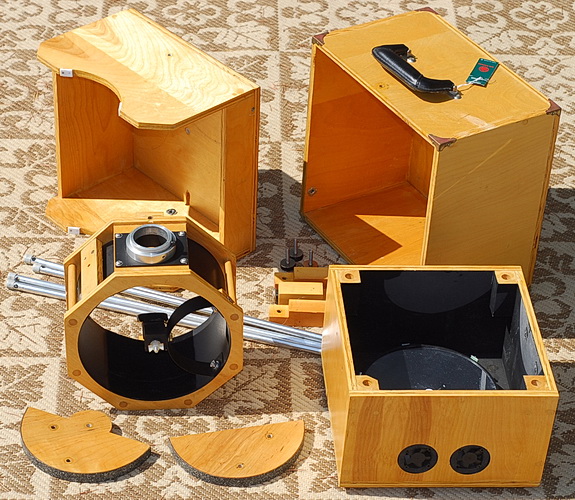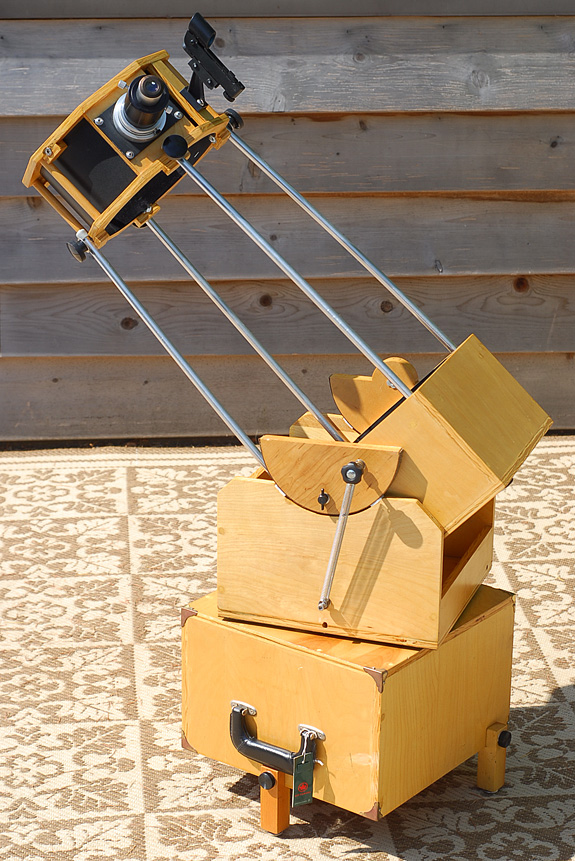-
Posts
53,874 -
Joined
-
Last visited
-
Days Won
458
Content Type
Profiles
Forums
Gallery
Events
Blogs
Posts posted by John
-
-
Celestron C5 SCT''s are compact and quite light at 2.8kg for the optical tube.
-
 4
4
-
-
19 minutes ago, Astrosurf said:
... So some people don't have the white bolts at all?
They have the white bolts but they don't use them - they leave them loose. I used to do that with my Orion Optics newt, unless I was taking it somewhere in the car.
Often locking bolts are a different size (smaller usually) than the collimation bolts but GSO have chosen the colour scheme and sizes you have. This is the back end of the Stellalyra 8" F/4:

-
Here is another video of a different (though very similar) B&C refractor being taken apart. This one shows what should be in the tube at the opposite end to the objective lens. I think it's called an erecting or terrestrial eyepiece:
-
1 minute ago, Astrosurf said:
Thank you. I never know how tight is tight. Just to the point the bolts stop turning?
The point of them is to stop the mirror cell moving so just gently pressing against it.
Some folks don't use locking screws unless the scope is being transported. The springs on the tilt adjustment ones should be strong enough to hold the cell in the correct position during normal use. I say "should" but in the 10 and 12 inch sizes the GSO springs are notoriously weak and are usually promptly upgraded by owners. I'm not sure this is the case with the 8 inch apertures ones though 🤔
-
In times gone by a slip up like that that would have merited a steaming letter to The Times signed "Angry of France" 😄
-
The black ones with springs adjust the tilt of the primary. The white ones are locking ones and should be loosened before adjusting the black ones and then just lightly tightened down once collimation of the primary is achieved. The cell looks like a GSO made one so it will be the same as the Stella equivalent.
The mirror cell in these scopes is made of quite thin metal so tightening the white ones too much actually warps it a little, affecting the collimation. Just lightly snugged up against the cell is what is needed for the white ones.
-
If the objective lens is 3 inches in diameter the scope looks very much like the Broadhurst Clarkson "Starboy" model. Sir Patrick Moore's first scope was the same model.
I recently acquired one of the last batch made at 63 Farringdon Road in 1992. Yours will be much older than that - 1930's perhaps ?
Here is a tidied up one:
Vintage Telescope, Tripod, Broadhurst Clarkson, London, Starboy, Astro – London Fine Antiques
-
 1
1
-
-
3 hours ago, LondonNeil said:
I was about to say a sct or mak gives a very compact form for FL, but that Dall example is incredible!
My previous travel scope was a 90mm mak.
I'm looking for more aperture and wider fields of view with a future travel scope I think.
-
Mount payloads should be taken with a pinch of salt IMHO.
The length of the scope tube can also play a significant role in how much stress is put on the mount and tripod. The refractors discussed here are not all that long however.
-
Reading Roger Vine's report, I didn't realise that the ST102's used a wider air space to better control CA. I know that Tele Vue and Tak used that approach in some of their refractors but didn't know that Synta did too 🤔
I've only owned 1 ST102 which was a Celestron branded one. I didn't intend to keep it (it came with a mount that I was after) but I do recall thinking that the CA levels were quite low when I tried it before parting with it.
-
45 minutes ago, Elp said:
If this, then anythings technically portable.
True but my car is small and my other half seems to need around 75% of the stowage space !
-
 1
1
-
 2
2
-
-
1 hour ago, JeremyS said:
...And well done for bucking the trend for RACI finders. 😊
Have you seen Matthew lately ? 😄

-
 6
6
-
-
Hmmm .......
I've just read Roger Vine's review of the Skywatcher ST 102 F/5 achro. Maybe this is an option ?:
Sky-Watcher StarTravel 102 Review (scopeviews.co.uk)
-
 2
2
-
-
10 minutes ago, Louis D said:
I only travel with my 25 year old ST80 in case the car gets broken into. It hasn't happened yet, but if it did, I'm not out a very expensive scope.
The Heritage 130 might be an option if you can come to grips with its focuser and other foibles.
Or, build your own suitcase Dob:
I love the look of that traveldob 🙂
-
We stayed at a remote cottage on Dartmoor a couple of years back. The skies were the darkest that I've experienced in years. I only had binoculars on that trip but I recall thinking a number of times on the clear nights, "goodness knows what I'd be able to see here with 4-5 inches of aperture" 🙂
-
 1
1
-
-
2 minutes ago, JeremyS said:
By travel, do you mean by car rather than plane?
A Newt is going to get bulky quite quickly, for travel. Perhaps something like a SW Heritage. Can be mounted on a altaz mount so you wouldn’t need the Dob base. I’ve Heritage 150. Nice scope bought with the aim of car travel. Found it a bit of a faff. Much prefer my Tak FC 76DCU.By car. We tend to tour when we have flown abroad so I take binoculars for those trips.
I have wondered about the Heritage 130 newt as an alternative OTA 🤔
-
 1
1
-
-
A while back I acquired a nice little 70mm ED refractor to use (mostly) as a travel scope. This little refractor is just 30cm long when in it's compacted form, weighs around 2kg and sits nicely on a lightweight alt-az mount on a good quality photo tripod.
I have taken this rig away with me a couple of times and I've enjoyed using it under unfamiliar skies. It is a good performer, for a 70mm aperture scope.
Lately though I've been wondering if I might be better served, for travel, by a larger aperture, but still compact, scope such as a small, fast newtonian. My musing is along the lines of, I'm taking a scope away with me to use under hopefully darker skies so why not have something with a bit more aperture than 70mm to exploit that, assuming that the most likely goals will be deep sky targets rather than the higher resolution / higher power targets, which I can observe from home with a somewhat more powerful range of apertures.
I guess I'm thinking of what used to be termed a "rich field" type instrument ?
I want to stick with something that can work happily from the light alt-az mount / good photo tripod so I reckon that something around 100mm-130mm F/5-ish would be the max OTA aperture that I can get away with. Not bothered about 2 inch eyepieces particularly for this one, GOTO or a driven mount. I'm very much traditional "visual only" as well 🙂
So just kicking ideas around currently and I'd be interested to hear if anyone else has been through similar thought processes when considering a scope to take travelling ?
This is my current travel scope:

-
 1
1
-
-
I think a dew shield is almost essential with an SCT. Other than that, you have a good setup now so can enjoy developing your experience by using it as often as you can 🙂
-
I've owned both the 2.5x Powermate and the Baader VIP. Both excellent.
I have the XW's in 3.5, 5, 7 and 10mm but went for a TV Delos at 14mm and above because of the reports of field curvature with the 14mm and 20mm XW's.
Not so much of an issue in an F/9 refractor though.
-
The eye relief is measured from the centre of the top surface of the top lens in the eyepiece. That does not change whatever the position of the eye cup is. What does change is the amount of that eye relief that is actually useable because the eyecup positioning eats into the 20mm more and more as it is raised.
So those who wear glasses and need more eye relief will find having the eye cup at or close to, the lowest position works best. Those who don't wear glasses will generally find that the eyepiece works best with the eyecup at, or close to, the highest position. Pentax's own instructions for the XW eyepieces actually state this.
-
 4
4
-
-
Great reports and sketches 👍
I love to try and pick out NGC 6207. Widefield eyepieces help to frame both it and Messier 13 in the same field while maintaining enough magnification to tease to galaxy out.
I've seen NGC 6207 with my ED120 refractor on a decently dark night here.
-
6 hours ago, Louis D said:
My understanding of the TV Plossl design is that Al Nagler made the two outer elements slightly concave to improve edge sharpness. The success of his Plossl design's sales gave him the financial wherewithal to bring the 13mm Nagler Type 1 to market.
I agree. This is from the original Tele Vue patent documentation:

-
 3
3
-
-
I've moved onto Hercules now and it's 3 globular clusters. The very famous Messier 13, the nearly as well known Messier 92 and the more obscure NGC 6229. The latter globular cluster is 4 times further away than M13 and M92 and correspondingly fainter. I posted a little report on this interesting object back in 2021:
https://stargazerslounge.com/topic/378625-hercules-3rd-globular-ngc-6229/
-
 8
8
-
-
A few rogue clouds around but generally clear here tonight. I've just been looking at Comet C/2023 A3 Tsuchinshan-ATLAS in Virgo. It's a small faint elongated patch of light with the ED120 refractor at 64x. Could be taken for a galaxy in this region of the sky.
Glad to see it though 🙂
-
 10
10
-














Altair 200 Collimation
in Getting Started Equipment Help and Advice
Posted
The old GSO 8 inch newtonians used to get criticised for having small and fiddly collimation and locking bolts which needed different tools for the different screw heads. I guess they responded to that with the larger, "no tool" bolts that are fitted today.
At the end of the day though, they are just bolts, so I guess they could be replaced with something with a lower profile 🤔